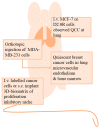Towards a Framework for Better Understanding of Quiescent Cancer Cells
- PMID: 33807533
- PMCID: PMC7999675
- DOI: 10.3390/cells10030562
Towards a Framework for Better Understanding of Quiescent Cancer Cells
Abstract
Quiescent cancer cells (QCCs) are cancer cells that are reversibly suspended in G0 phase with the ability to re-enter the cell cycle and initiate tumor growth, and, ultimately, cancer recurrence and metastasis. QCCs are also therapeutically challenging due to their resistance to most conventional cancer treatments that selectively act on proliferating cells. Considering the significant impact of QCCs on cancer progression and treatment, better understanding of appropriate experimental models, and the evaluation of QCCs are key questions in the field that have direct influence on potential pharmacological interventions. Here, this review focuses on existing and emerging preclinical models and detection methods for QCCs and discusses their respective features and scope for application. By providing a framework for selecting appropriate experimental models and investigative methods, the identification of the key players that regulate the survival and activation of QCCs and the development of more effective QCC-targeting therapeutic agents may mitigate the consequences of QCCs.
Keywords: cancer; detection; dormancy; model; quiescence.
Conflict of interest statement
The authors declare no conflict of interest.
Figures



References
-
- National Cancer Comprehensive Network (NCCN) Breast Cancer, Version 4.2020, NCCN Clinical Practice Guidelines in Oncology. [(accessed on 16 June 2020)]; Available online: https://www.nccn.org/professionals/physician_gls/pdf/breast.pdf.
Publication types
MeSH terms
Grants and funding
LinkOut - more resources
Full Text Sources
Other Literature Sources
Medical

